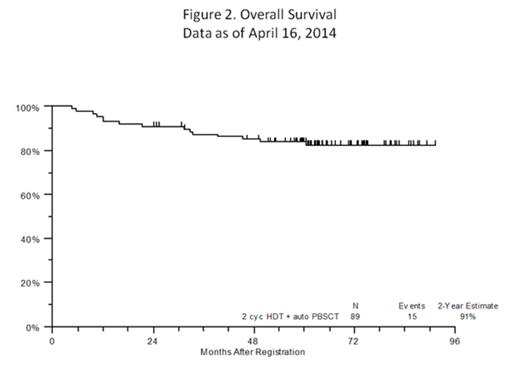Abstract
Background: The SWOG 9011 trial of augmented conditioning regimens (12 Gy TBI or BCNU 15mg/kg with both etoposide 60 mg/kg and cyclophosphamide 100 mg/kg) prior to single AHCT for pts with relapsed or refractory HL demonstrated 5-yr PFS and OS of 41% and 54% respectively in 74 treated pts. Among 46 previously irradiated pts with 2-3 high risk features, the 5-yr OS was 38% compared with 60% for pts with 0-1 risk features. Post-AHCT relapse was the major cause of failure (Stiff et al. BBMT 2003; 9:529). The strategy of sequential high-dose (HD) chemotherapy + tandem AHCT for poor prognosis HL patients was investigated in a City of Hope (COH) & Loyola University (LU) pilot trial of tandem AHCT in 46 HL pts with primary progressive or relapsed HL with at least 1 poor-risk feature. Trial results were promising, with 5-yr OS, EFS and FFP of 54%, 49% and 55% respectively and 100-day TRM of 4% (Fung et al. BBMT 2007;13:594). The purpose of the SWOG led trial S0410 was to evaluate the COH/LU regimen in a phase II cooperative group setting, with the primary endpoint of 2-yr PFS.
Methods: Pts with refractory/relapsed HL, eligible ages 15 -70, were enrolled after salvage therapy & stem cell collection (minimum 3.5 X 10.6 CD34/kg). Pts with relapse after prior CR received minimum of 2 cycles salvage chemotherapy or minimum of 25 Gy involved field radiation therapy (IFRT) to determine if they had sensitive or resistant HL. Pts with late relapse (> 12 months after 1st CR) responsive to salvage therapy were excluded. Pts with > 5cm bulk disease after salvage had to agree to 18 Gy IFRT pre-AHCT. A designed sample size of 85 pts over 2-yrs with 18 months follow-up was chosen to have 86% power by 0.025 one-sided alpha test to detect a 15% increase in 2-yr PFS as compared to the historical 2-yr PFS of 45% in S9011. After IFRT to bulk disease pre-AHCT, pts were treated with cycle 1 HD-Melphalan (150 mg/m2) + AHCT. If response after cycle 1 AHCT was SD or better, pts had 2nd AHCT with one of the two HD regimens used in SWOG 9011. Interval between day zero of 1st and 2nd AHCT had to be at least 28 days & not greater than 60 days.
Results: 98 patients enrolled from 10 institutions including the BMT CTN. Six ineligible pts had inadequate PFTs (1), incomplete baseline testing (3) or failure to confirm pathology by central review (2). Median age was 34 yrs (range 18-60), 45% had refractory disease, 42% had B symptoms, and 24% had extranodal disease at transplant. Of the 92 eligible pts, 89 were treated, 82 completed both cycles of AHCT and 7 pts did not have 2nd AHCT (1 progressed, 1 declined TBI, 4 with > 60 days since 1st AHCT, 1 poor graft after C1.) Of 89 pts assessed for toxicities, 70 had grade 4 AEs, primarily hematologic and 14 of those pts had grade 4 non-hematologic AEs. Treatment-related mortality was 0%. With median follow-up of 5.4 yrs (range 2 -7.6 yrs), the 2-yr PFS was 63% (95% CI: 52%, 72%) and 2-yr OS was 91% (95% CI 83, 95%), as shown in figures 1 and 2 respectively. There were 15 deaths in eligible pts, 2 deaths in ineligible pts, and 3 deaths in inevaluable pts who did not receive protocol therapy. Of the 15 deaths in eligible and evaluable patients, there were 11 deaths due to progressive HL, 1 death due to non-treatment related respiratory failure, 1 death due to disseminated CMV infection and 2 deaths with primary cause not reported. Late malignancies were mylelodysplasia in 2 pts, thyroid cancer in 1 pt, and 2 pts with non-melanoma skin cancer.
Conclusions: The 2-yr PFS of 63% in pts treated with tandem AHCT on S0410 met the predicted study endpoint of at least 15% improvement compared with the 2-yr PFS of 45% in the S9011 trial of augmented HCT conditioning prior to single AHCT. The better-than-expected OS of 91% in S0410 is attributed to the current treatment strategies for progressive or relapsed HL after AHCT, including brentuximab vedotin (BV) salvage and allogeneic HCT, which can lead to a significant percentage of long term survivors. Analysis of prognostic features will be conducted to ascertain if a model can be developed to identify a very high-risk group of HL pts who should be considered for early allogeneic HCT. Next steps will need to take into consideration results of the recently completed trial of BV consolidation after single AHCT; however, the S0410 results are very promising considering the patients had poor-risk relapsed and refractory HL.
Support: CA32102, CA38926
Fisher:Johnson & Johnson : Consultancy; MorphoSys AG: Consultancy.
Author notes
Asterisk with author names denotes non-ASH members.



This feature is available to Subscribers Only
Sign In or Create an Account Close Modal